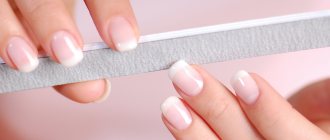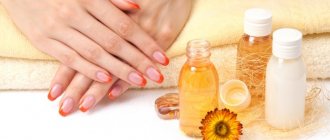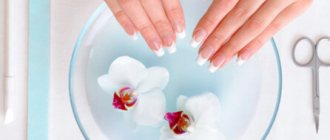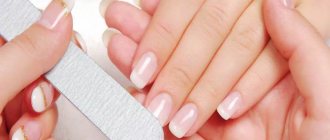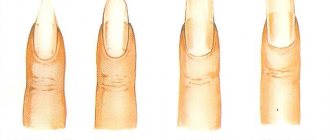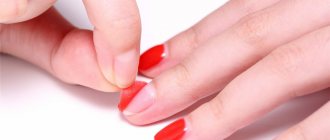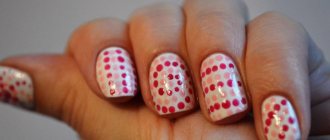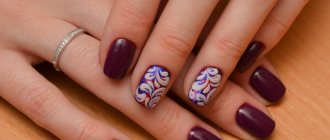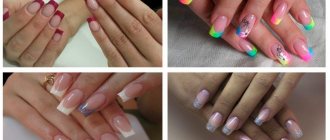Beautiful hands are the calling card of a well-groomed woman. There is nothing more attractive than strong, well-shaped nails that shine with a healthy shine. This detail will not go unnoticed, because natural manicure is always in fashion. But due to a lack of vitamins, daily household chores and frequent application of decorative varnish, nail plates can become fragile. In addition, in particularly advanced cases, nails can suffer from fungal diseases. Natural essential oils will help get rid of these troubles and restore the health of your nails and cuticles.
How do oils work?
Essential oils have the ability to penetrate deep into the nail plate
To treat nail fungus with essential oils, products with pronounced antimicrobial and fungicidal properties are used. Such oils act simultaneously in several directions:
- disinfect the nail plate,
- destroy adult pathogenic microflora,
- prevent the spread of fungal spores to healthy skin and nails,
- create an acidic environment on the surface of the nail, which is unsuitable for the further functioning of the fungus.
At the same time, the oils eliminate discomfort, eliminate unpleasant odor if mycosis is localized on the feet, and improve the appearance of the skin and nails.
To speed up recovery, it is recommended to combine essential oils for fungus with medications for the treatment of onychomycosis. They can be used to prepare for the application of cream, ointment or antifungal varnish.
Properly selected oil does not cause allergies, burning or other negative reactions. Oils do not interact with medications for fungus, so they are safe to use both as an independent remedy and as part of complex therapy for onychomycosis.
The oil penetrates deep into the nail plate, softens it, thereby facilitating the process of caring for nails affected by fungus. Such products improve local blood circulation, increase the protective functions of the skin and prevent the fungus from spreading to healthy areas.
Basic procedures
Essential oils are used in a variety of ways. We will talk about the most popular ones.
Hand baths
To increase the effectiveness of the baths that you usually do for your nails, you need to add three drops of the oils listed above, to your taste.
The duration of the procedure should be 20 minutes, and the bath temperature should not exceed 40 degrees. If you work with chemicals, it is better to take a bath with tea tree or eucalyptus oil.
When the nails and hands are blackened and roughened, a bath with serum and grapefruit or lemon oil is suitable.
Oil masks
Hands are pre-steamed, then a mixture of base and selected essential oils is rubbed into the nails for five minutes. Bergamot and rose oils are good for prevention.
Compresses
This method is suitable for cracked nails. You need to moisten a napkin in a mixture of essential and base oils, apply it to the plates and insulate it with a towel on top. The compress is kept for 15 minutes.
Homemade creams
To make nail cream, you need to take herbal infusion (two tablespoons), add butter (50 grams), honey (one tablespoon) and base (two teaspoons). Melt everything in a water bath, stirring thoroughly. Cool and add two drops each of geranium, ylang-ylang and rosemary essential oils. The cream is used morning and evening and stored in the refrigerator. This homemade cream rejuvenates and strengthens nails well.
Is it possible to take tea tree oil internally?
There is no consensus on taking tea tree oil internally. Some experts argue that this aromatic oil should never be consumed internally, as diarrhea, vomiting, disruption of the immune system may occur, and in more difficult cases, a person may fall into a coma.
Others believe that the product can be used orally for the purpose of antiseptic effects on the mucous membrane of the gastrointestinal tract. The purposes of internal use are as follows:
- fight against intestinal infections and parasites;
- assistance in eradication of Helicobacter;
- stimulation of the immune response in the gastrointestinal tract;
- ease of digestion;
- accelerating the regeneration of minor mucosal defects.
It is advisable to use the oil internally only under the supervision of a doctor. People suffering from polyvalent allergies should be especially careful.
Tea tree oil is prescribed in drops. For an antiseptic effect - 5 drops 4 times a day diluted 1:1 with any edible oil.
To stimulate regeneration, 6 drops per day, divided into 2 or 3 doses, is enough. Be sure to dilute in a ratio of at least 1:1, and preferably 1:2 with edible oil.
RULES FOR USE OF ESSENTIAL OILS FOR FUNGUS NOTES
After choosing the right essential oil, the first thing you need to do is test for an allergic reaction. To do this, you need to apply a few drops of essential oil to your wrist or inner surface of the elbow and monitor the body's reaction. If after some time there is no itching or redness, then the oil can be safely used.
When using essential oils for nail fungus, you should follow a number of rules:
1. Before applying essential oil to the affected area, it should be diluted with a carrier oil. The mixture must be rubbed not only into the nail plate, but also into the skin around it;
2. When using essential oils in the form of applications, to achieve the best effect, you can make a mixture of different essential oils in equal proportions. A tampon or cotton pad soaked in the prepared mixture is applied to the affected area and secured with a bandage or adhesive tape;
3. To increase the effectiveness of treatment, you must first steam your nails in a bath using tar soap or soda. Adding a few drops of essential oil to the bath will also have a beneficial effect on the health of your nails.
Composition of tea tree oil
The tea tree is a low shrub or small tree belonging to the myrtle family (Myrtaceae). There are many varieties of tea tree, but only Melaleuca alternifolia has significant therapeutic properties.
Tea tree essential oil is obtained from the leaves and branches of the tea tree by distillation. Tea tree oil contains:
- alpha-pinene,
- alpha-terpinene,
- limonene,
- para-cymene,
- cineol-1.8,
- gamma terpineol,
- terpinolene,
- terpene-4-ol,
- alpha-terpineol, etc.
Most "therapeutic grade" tea tree oils contain about 3% cineole, with terpene-4-ol contents of 35% or more. . This will be an original oil with optimal bactericidal properties, but minimal risk of irritation.
Tea tree essential oil is a natural topical remedy with a wide range of effects. It has antiseptic, antifungal, antiviral, anti-inflammatory, regenerating and immunostimulating effects.
What does a tea tree look like, photo
The oil effectively inhibits the growth of bacteria such as staphylococci, streptococci, pneumococci, gonococci, E. coli and a number of others, as well as fungal flora. The disinfecting properties of the oil are used in medicine, hygiene, and cosmetology.
The oil helps eliminate acne, warts, papillomas, dandruff, fungal skin infections, and is effective against insect bites, abrasions, and cuts. Strengthens hair follicles, which improves hair growth and structure.
It has a calming aromatherapy effect, helps restore the body after stress, relieves anxiety, and promotes concentration. The aroma imparts reasonable determination, preventing panic and hysteria.
So, tea tree oil is a unique, powerful natural antiseptic that is able to overcome even antibiotic-resistant pathogens. The compounds it contains are harmful to staphylococcus and streptococcus, as well as fungal and viral infections.
Essential oils for hand care
Essential oils for hands
Each type of this product has its own purpose. There is an essential oil that is used to strengthen nails. There are those that add shine to them and soften the cuticle.
Effective oils:
- Eucalyptus. A product that moisturizes nails, heals and disinfects small damage. Also, adds shine to the nail plate.
- Lemon essential oil. It has an antibacterial and antiseptic effect, so it quickly heals any wounds on the cuticle. In addition, it whitens the nail plate and gives it shine. Lemon oil for nails promotes their growth.
- Grapefruit-based product. Its effect is very similar to lemon.
- Tea tree. Helps heal and restore the cuticle. An oil solution that is used for nail growth.
- Sandalwood helps to heal not only wounds, but also cracks in the cuticle area. It strengthens the nail plate and prevents its delamination.
- An oil composition based on myrrh has a healing effect, heals cracks, and reduces the inflammatory process on the cuticle. Strengthens nails and protects against splitting. Nourishing and antiseptic, one of the best.
- Rosemary mixture promotes nail growth. Not only heals, but also whitens the nail plate.
- An oil solution based on ylang-ylang strengthens and protects against delamination. To get the effect, just one drop during polishing is enough to make your nails shine.
To moisturize the cuticles and nails, you can lubricate them with geranium essential oil. Lavender essential oil has a strengthening effect, which promotes the growth of the nail plate and heals minor damage to the cuticle.
